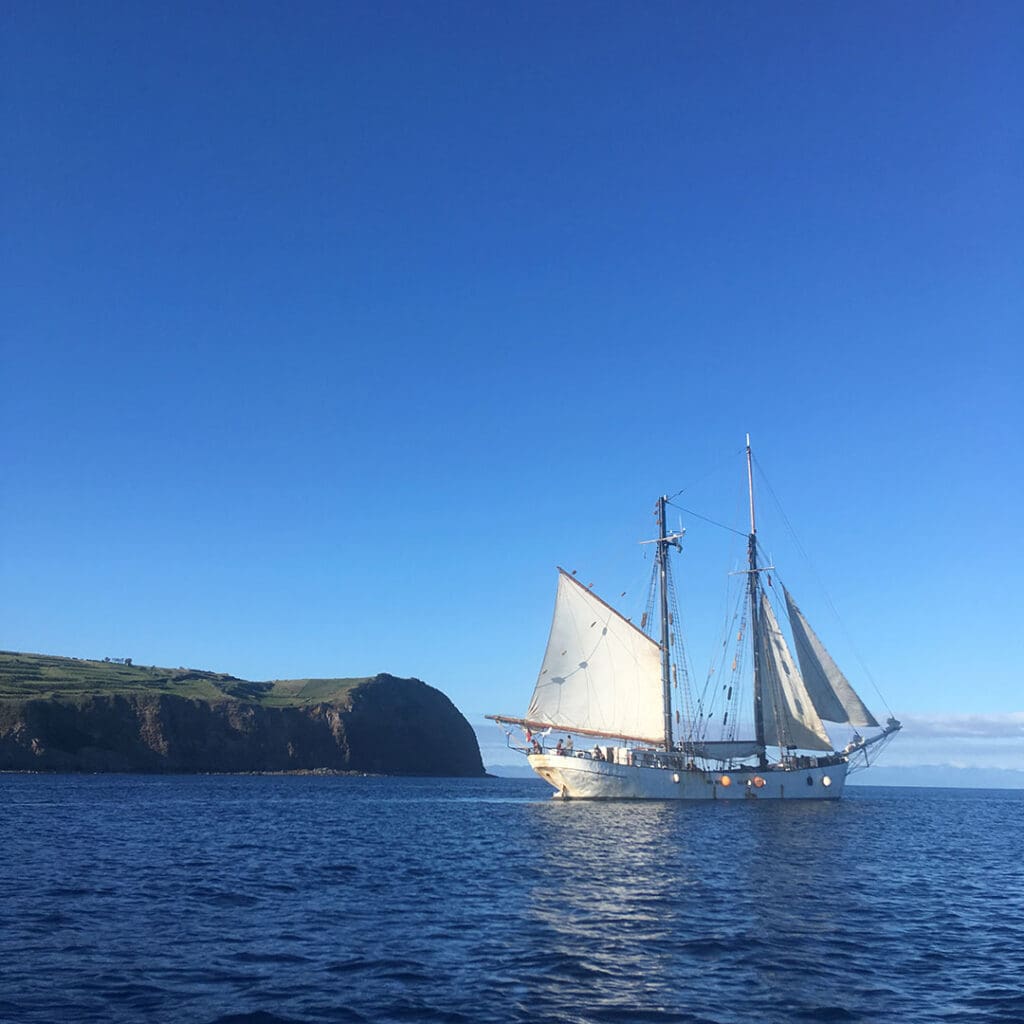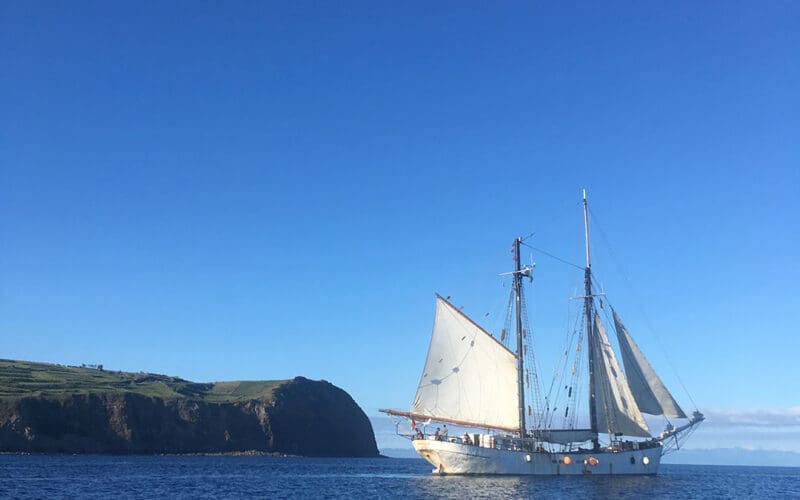
A hundred and fifty years ago big ships under sail crisscrossed the Atlantic Ocean, sailing south from Europe to cross on the trade winds then up the coast of the Americas to return on the westerlies. With current concerns over climate change driving the need to cut carbon from using fossil fuels, will we once again see fleets of ocean-going trading boats loaded down with flying canvas and no engines?
A recent book, Trade Winds: A voyage to a sustainable future for shipping, by Christiaan de Beukelaer looks at the complex journey the shipping industry is on to cut its carbon emissions. The path to book started when De Beukelaer signed on for a three-week stint on 143-foot gaff-rigged schooner Avontuur in the Canary Islands. He expected to only be aboard for a trip to deliver a cargo transatlantic. When the COVID pandemic hit, however, he found himself a part of the crew for a five-month pandemic-extended odyssey. While many seafarers experienced delays in those months, including cruising boats trying to get home, Avontuur’s story is different. Avontuur is a sail cargo ship owned by Timbercoast Pty Ltd, a German company that sees itself as a missing link between sustainable producers and conscientious consumers. It runs a tramp cargo service in European and Caribbean waters to deliver value-added luxury goods in an attempt to show that global shipping can once again be done under sail.
De Beukelaer was born in the Netherlands and is currently on the faculty of the University of Melbourne, Australia. I spoke with him about sailing and his belief that we need to move away from fossil-fueled shipping. My first question was how he got into sail cargo. De Beukelaer is an anthropologist of policy. When early work in cultural policy became frustrating, he changed tacks to help deal with the climate crisis by focusing on climate policy. “In making that shift I thought, where in research can make a difference? Shipping! It was completely lacking in climate ambition. It wasn’t until 2018 that the IMO finally set a goal of cutting shipping emissions in half by 2050 and to zero as soon as possible.”
When steam engines appeared on ships in the nineteenth century, sailing ships got faster to try to compete. By 1938 when the discovery of vast quantities of oil in Saudi Arabia ensured the world’s dependence on fossil fuels, the remaining long-distance sailing trade routes had disappeared and now blue jeans, Nike sneakers, peanuts, chopsticks, and all manner of consumer goods go on huge steel vessels powered by engines kept fueled by other ships which trade in those fossil fuels.
According to de Beukelaer, some goods cross oceans five times before being sold, and shipping accounts for 3 per cent of global carbon emissions. This may not seem like a lot but it happens mostly out of sight with ports having moved from inner city wharves to gated shipping compounds, and our appetite for consumer goods continues to grow, pushing toward ever greater expansion.
Much of the language addressing climate change is not always clear; international “climate ambition” efforts at “decarbonization” are led largely by Europeans, who work with the UN’s International Maritime Organization (IMO) and other agencies to bring the world to “net zero.” Urgent schemes to do so are “high ambition.”
Modern-day trans-ocean sail cargo has been around for a while. In 2007 three friends in the Netherlands started the company Fairtransport. They renovated a 105-foot brigantine they named Tres Hombres, and began trading rum, cocoa, coffee and olive oil. The movement builds on the sail training idea where people pay to learn on large sailing ships. Avontuur began trading in 2016 with a paid professional crew of six and 10 paying trainees who work as members of the crew.
De Beukelaer’s focus on traditional sail cargo vessels was inspired by neighbors in Amsterdam involved with Tres Hombres. As a researcher he was interested in shipboard culture and not the intimate lives of its crew members, which made integrating difficult because the crew had already been together for a month. Neither he nor anyone else could predict that a few weeks out of the Canaries, the ship’s owner would text the captain that “The world as you know it no longer exists” and he would have five months to become a full crewmate.
De Beukelaer does a good job in his book of explaining the need to decarbonize shipping, how we got here and how we might accomplish this goal. The reader comes away skeptical of competing schemes by international partners for meeting shared goals — the year set for goals keeps changing. The idea of net zero is about balancing the carbon we produce but zero emissions means giving off no carbon at all, a scheme to reduce carbon by half depends entirely on the baseline year proposed for comparison. The urgency of IMO’s goals for global shipping has spawned new technologies and ideas, including retrofitting existing ships with sails, designing new fossil fuel ships for sail assist, green fuels including methanol, hydrogen, and ammonia. “Slow steaming” requires ships to cruise at optimum speed for minimum fuel consumption. Ships equipped with scrubbers have vastly reduced smokestack pollution but they need fuel to run.
In the end, however, de Beukelaer concludes that nothing — including sail cargo — can solve the carbon problem unless we drastically reduce the volume of stuff shipped. Any gain made through creating fuel efficient ships is all but guaranteed to be eaten up by increasing pressures to make and consume more goods. Which means cutting back on everything from Chilean apples to Norwegian oil.
It will, says de Beukelaer, require a sea change. It’s not something we can accomplish by reducing our use of plastic bags. We will have to work for structural change and that needs a political groundswell and lifestyle change, and if as a global community we can do that, then perhaps zero emissions sail cargo can work.
Three months after Avontuur picked up her first cargo, the ship was finally waiting for the right conditions to sail up the river to home port in Germany. Her owner was at risk of going bankrupt; his warehouse was emptying and his customers clamoring. As any cruising sailor knows, on time arrival is a myth.
Avontuur carries 100 tons of goods, whereas a small bulk carrier has a minimum capacity of 100 times that. Yet as a metaphor for the earth, being a finite resource on a finite sea, Avontuur’s pandemic voyage works great. “If you always want more than what you have,” says de Beukelaer, “then by definition, you’ll never have enough. But if you’re happy with less than what you can afford, or less than what you can store on your boat, then you’re bound to be happier. Because it means that when you set sail, you say ‘I have a little bit of space left, but I have everything I need.’ And that’s a very, very different logic to ‘If only I could afford a bigger boat to store all the things that I want.’” n
Contributing editor Ann Hoffner is an award-winning marine writer. She and husband Tom Bailey cruised on their Peterson 44, Oddly Enough. She’s now based in Sorrento, Maine.

